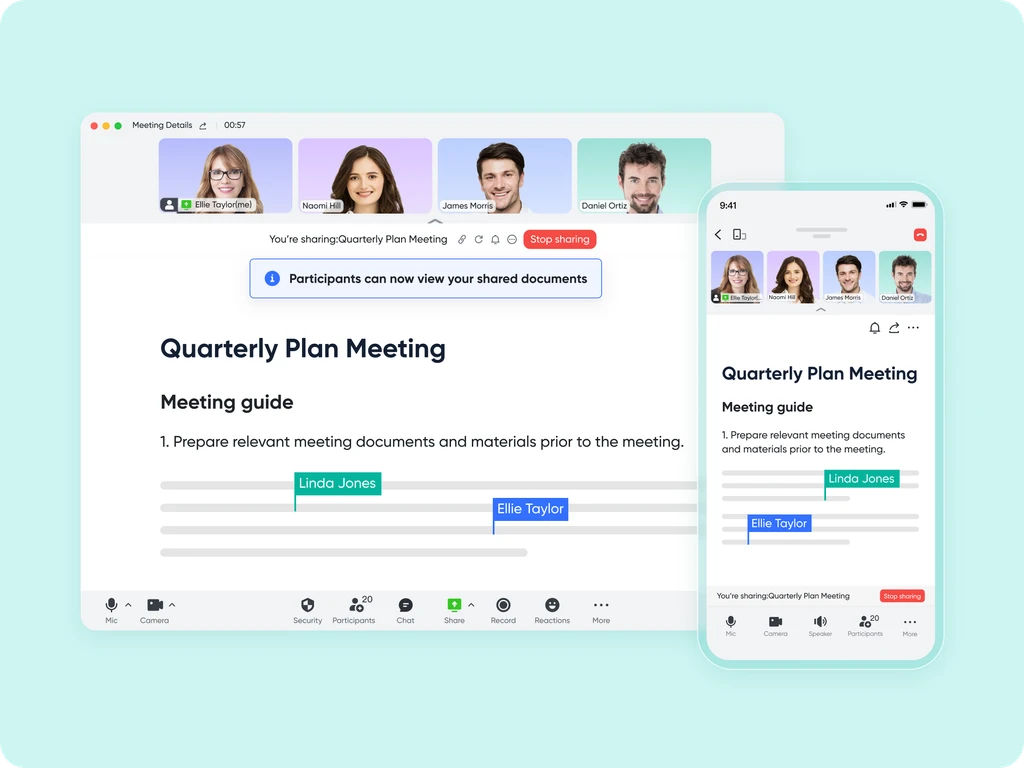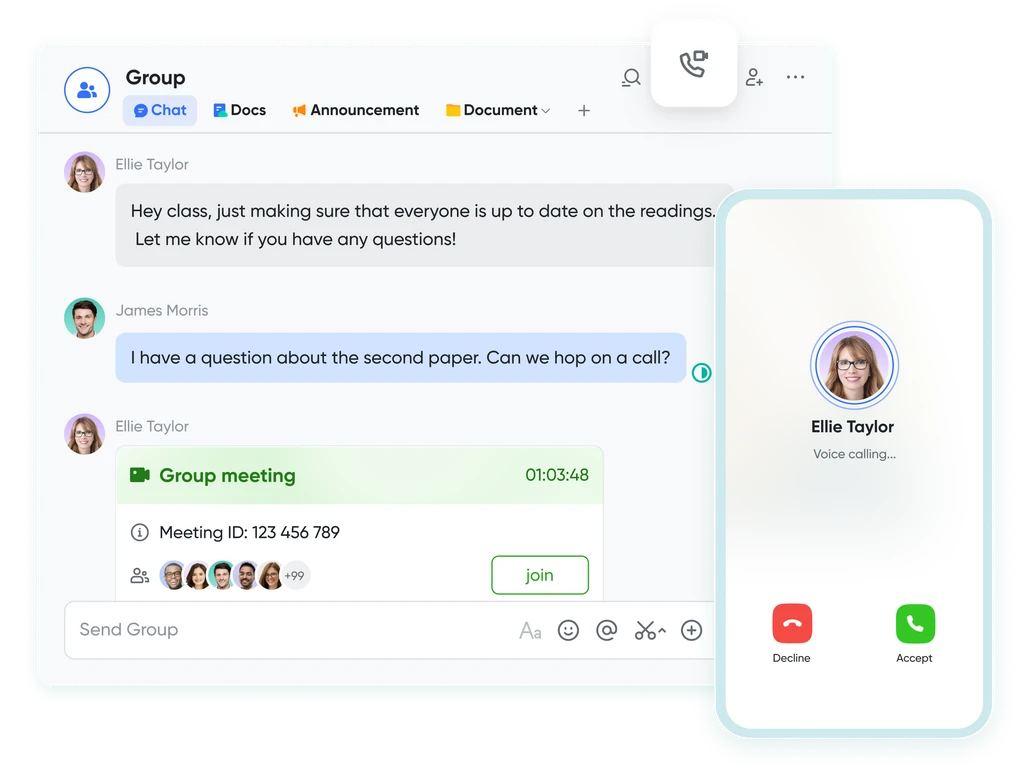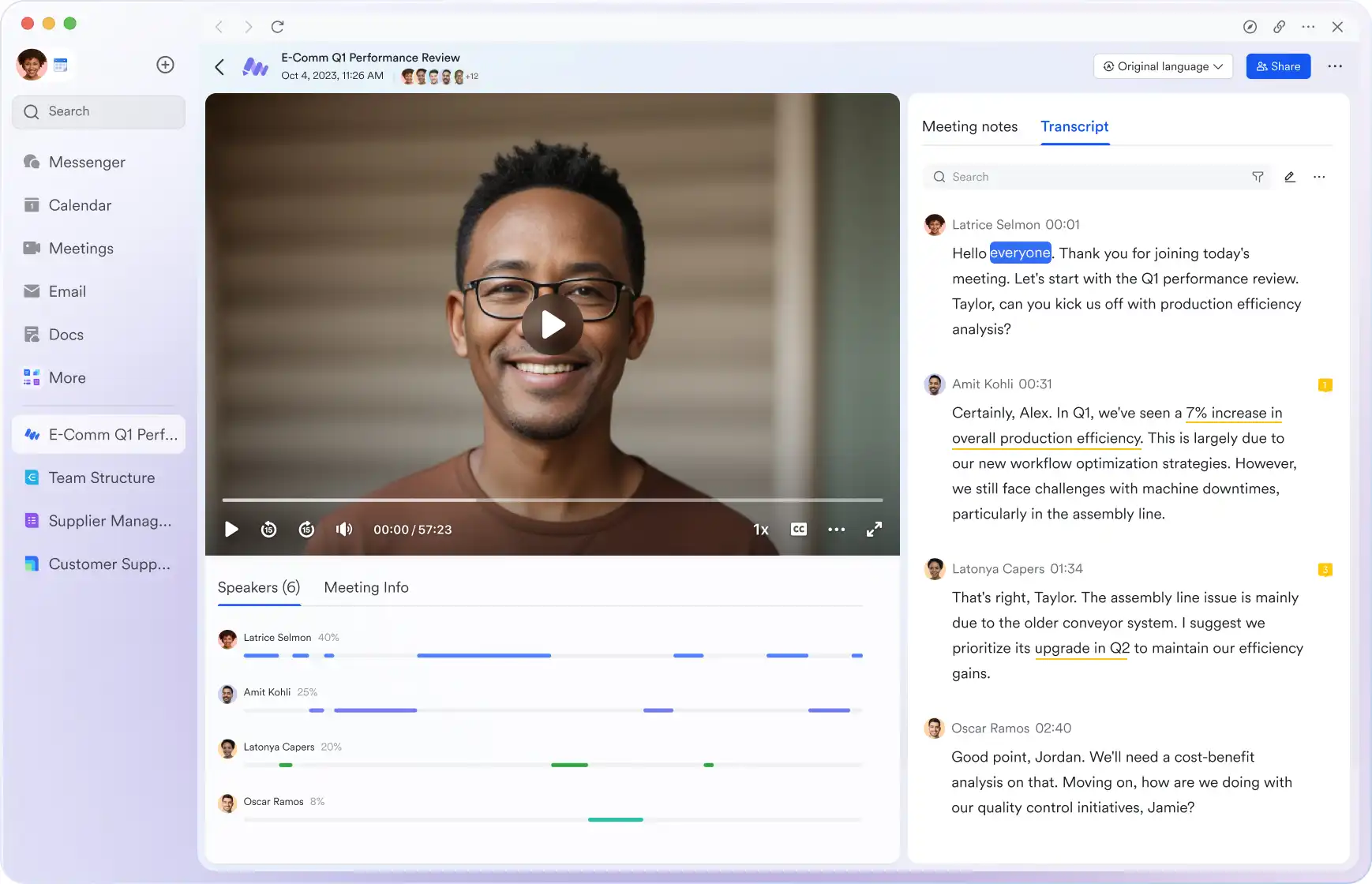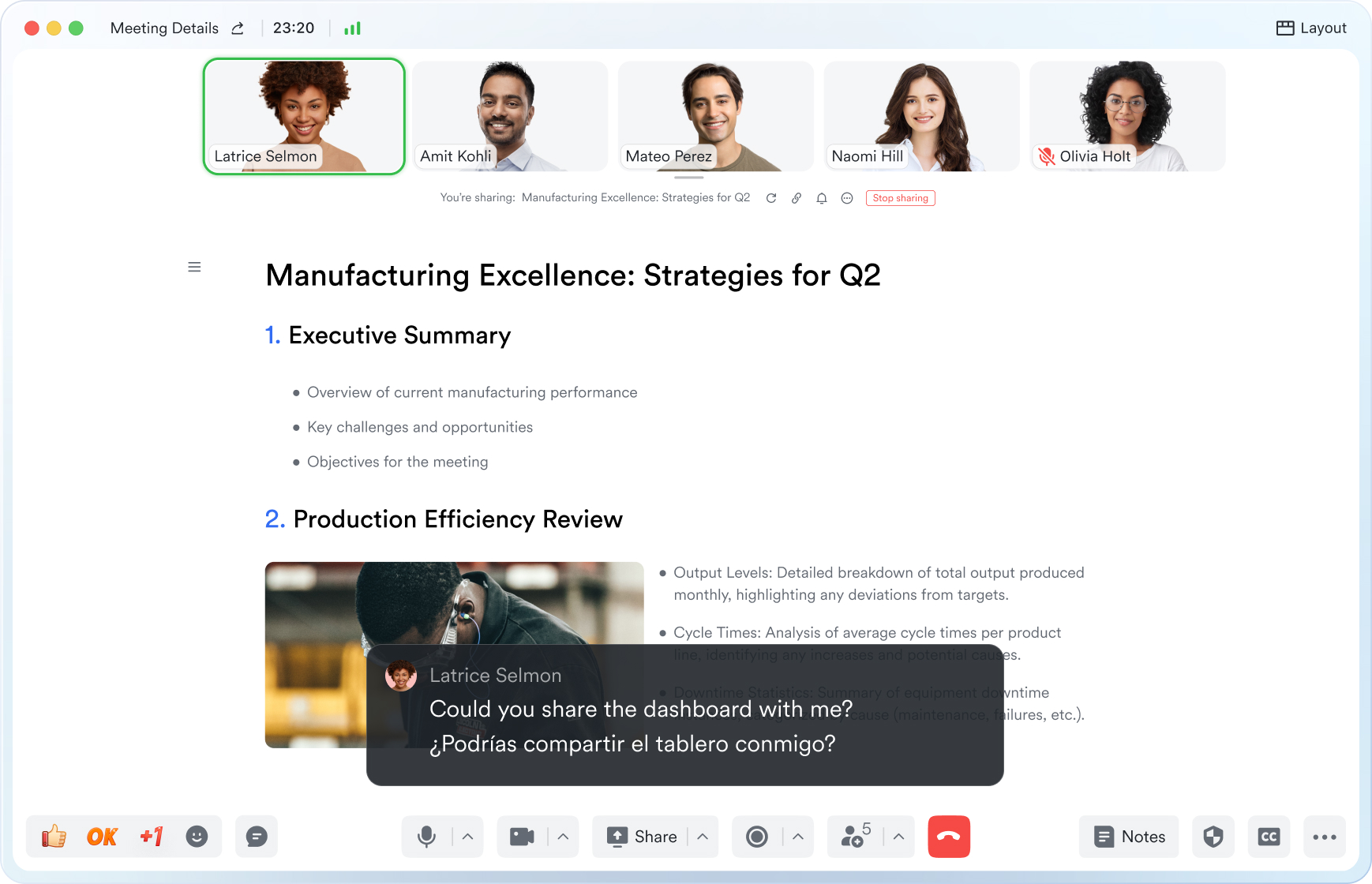Customer Discovery Meeting
This guide will walk you through the essential elements of use customer discovery meeting to keep your attendees aligned and engaged.
Try Lark for Free
Customer discovery meetings are pivotal in shaping a business's understanding of its clientele. In 2024, with the continuous evolution of consumer behavior and market dynamics, it is crucial for businesses to employ effective and innovative strategies to ensure the success of these sessions. This comprehensive guide provides a detailed roadmap for hosting proficient customer discovery meetings, encompassing the goals, participants, structure, frequent occurrences, virtual best practices, and more.
Use Lark Meetings to turn meetings into true collaborative experiences.
What is a customer discovery meeting?
A customer discovery meeting serves as a platform for businesses to gain profound insights into their customers' needs, pain points, and preferences. It is an invaluable tool for aligning business strategies with customer expectations, empowering organizations to deliver enhanced products and services. These meetings encompass interactive discussions and data collection exercises, aiming to uncover valuable customer-centric perspectives that can guide the company's strategic decisions.
Goals of customer discovery meetings
The primary objectives of customer discovery meetings revolve around understanding customer needs, validating product concepts, and uncovering market insights to refine business strategies. It aims to:
- Identify customer pain points and unmet needs.
- Validate assumptions about customer preferences and behaviors.
- Inculcate a customer-centric mindset within the organization.
Who should attend customer discovery meetings?
Customer discovery meetings should involve a diverse group of participants representing different facets of the organization, including product development, marketing, sales, and customer support teams. Key participants may include:
- Product Managers
- Marketing Specialists
- Sales Representatives
- Customer Support Personnel
- Executives and Decision-makers
Incorporating varied perspectives within the organization ensures comprehensive insights and promotes cross-functional collaboration.
Related:
Unlock the Power of Webinars: A Comprehensive Guide to Boost Your Business | Lark Blog | Lark BlogLearn more about Lark x Meetings
Topics, agenda, and structure of customer discovery meetings
The agenda for a customer discovery meeting should be carefully structured to cover a wide range of topics, ensuring that all key aspects are addressed effectively. A typical agenda may include the following elements:
- Introduction: Welcoming participants and setting the meeting objectives.
- Customer Persona Presentations: Sharing insights on different customer segments and personas.
- Feedback Sharing: Proposing questions and discussing feedback received from customers.
- Empathy Mapping: Collaboratively mapping customer experiences and emotional triggers.
- Solution Validation: Presenting potential solutions and gathering feedback.
- Action Planning: Identifying actionable steps based on the meeting outcomes.
The structure of the meeting should encourage active participation and facilitate open discussions to generate valuable insights.
Learn more about Lark x Meetings
How often do customer discovery meetings occur?
Customer discovery meetings should occur at regular intervals, aligning with the pace of product development, marketing campaigns, and customer feedback cycles. Typically, these meetings should be conducted:
- Quarterly for regular product updates and feedback review.
- Before launching new products or major updates.
- After significant market shifts or changes in customer behavior.
Key difference between customer discovery meetings and another similar meeting
The key distinction between customer discovery meetings and other similar discussions, such as sales or product strategy meetings, lies in their specific focus on gaining insights directly from customers. Unlike sales meetings, which concentrate on driving immediate transactions, and product strategy discussions, which often involve internal brainstorming, customer discovery meetings centralize on understanding customer needs and preferences through direct engagement.
Learn more about Lark x Meetings
Three practical examples of customer discovery meetings
- Tech Innovation Company: This company regularly organizes customer discovery meetings to gather insights into evolving customer needs, consequently enhancing its product innovation process.
- E-commerce Startup: Conducting customer discovery meetings helped this startup refine its marketing strategies, leading to increased customer acquisition and retention.
- Healthcare Provider: Through customer discovery meetings, this healthcare provider identified unaddressed patient concerns, shaping service improvements and patient satisfaction.
The aforementioned examples underscore the tangible benefits achieved through the effective orchestration of customer discovery meetings.
Common pitfalls of customer discovery meetings
Despite the potential benefits, customer discovery meetings can face certain challenges. Common pitfalls include:
- Biased Interpretation: Misinterpreting customer feedback due to preconceived notions or bias.
- Poor Participation: Inadequate involvement from key stakeholders hampers the meeting's effectiveness.
- Inadequate Follow-Up: Failing to follow up on identified action points and insights derived from the meeting.
Recognizing and mitigating these pitfalls is essential to ensure the success of customer discovery meetings.
Learn more about Lark x Meetings
Dos and don'ts of customer discovery meetings
| Do's | Don'ts |
|---|---|
| Actively listen and empathize with | Disregard or downplay customer feedback |
| customer perspectives. | |
| Encourage open discussions and diverse | Overwhelm participants with excessive |
| viewpoints. | information. |
| Follow up promptly on identified action | Dismiss or ignore valuable insights obtained |
| points. | from customers. |
The dos and don'ts table provides clear guidelines for conducting customer discovery meetings effectively, fostering an environment that values customer feedback and insights.
What makes a virtual customer discovery meeting successful?
Conducting successful virtual customer discovery meetings requires:
- Utilizing interactive virtual communication platforms.
- Providing pre-meeting materials to ensure active participation.
- Scheduling shorter, focused virtual sessions to maintain engagement.
By integrating these practices, businesses can ensure the seamless execution of virtual customer discovery meetings in the evolving landscape of remote interactions.
Learn more about Lark x Meetings
Typical takeaways of customer discovery meetings
Customer discovery meetings yield valuable takeaways, including:
- Refined product features aligned with customer needs.
- Insights driving marketing and sales strategies.
- Enhanced customer satisfaction and loyalty.
These key takeaways affirm the indispensable role of customer discovery meetings in shaping business strategies and offerings.
Questions to ask in customer discovery meetings
Effective questions to ask in customer discovery meetings include:
- What are the biggest challenges you face when using [product/service]?
- How could [product/service] better address your specific needs?
- What factors influence your decision-making when considering [product/service]?
These and similar questions help to extract meaningful insights and understand customer perspectives comprehensively.
Learn more about Lark x Meetings
Conclusion
In conclusion, hosting effective customer discovery meetings demands meticulous planning, open communication, and a genuine commitment to understanding and addressing customer needs. As businesses navigate the dynamic landscape of consumer preferences and market trends, embracing the insights garnered from customer discovery meetings becomes a catalyst for sustained growth and relevance.
Use Lark Meetings to turn meetings into true collaborative experiences.
A Game Changer for Customer Discovery Meeting: Empower your team with Lark Meetings
In the fast-paced and dynamic world of modern business, effective communication and collaboration are crucial for success of Customer Discovery Meeting. Here we introduce Lark Meetings to serve as a centralized hub for all communication needs.
Transform your meetings into collaborative endeavors

Leverage the potency of in-call document sharing, intelligent meeting minutes, and mobile-optimized features to enhance productivity collaboratively, irrespective of your location or schedule.
Seamlessly collaborate in real-time, across any device

Share live documents instead of just screen views. Participants can navigate and edit simultaneously within the video call window, even while on the move.
Shift your focus to engagement, not note-taking

Lark Minutes automatically converts video meetings into transcripts, facilitating easy viewing, searching, and collaborative editing. Stay in the loop asynchronously, even if you can't attend the live meeting. Lark Minutes for meeting minutes support translation into 10+ different languages.
Break language barriers in communication

Lark Meetings provide real-time translation for subtitles, allowing individuals from diverse backgrounds to express themselves in their native languages. Ensure every voice is heard, regardless of geographical location. Live subtitles currently support translations from English, Chinese, and Japanese to 10+ different languages. See more translation feature in Lark.
Connect with larger audiences
Host dynamic online meetings and events accommodating up to 1,000 participants, with the flexibility of up to 50 breakout sessions for intimate group discussions within the larger meeting context. Try more Lark features for free.








